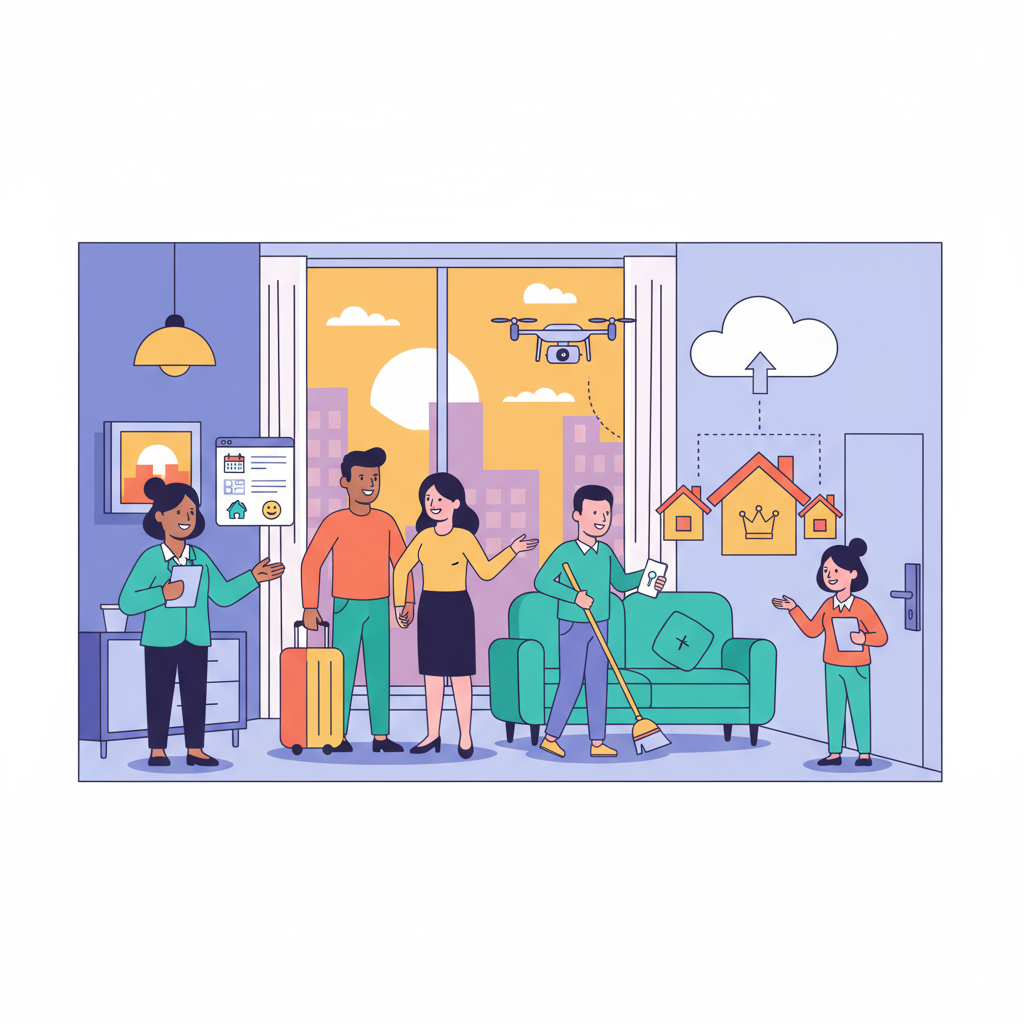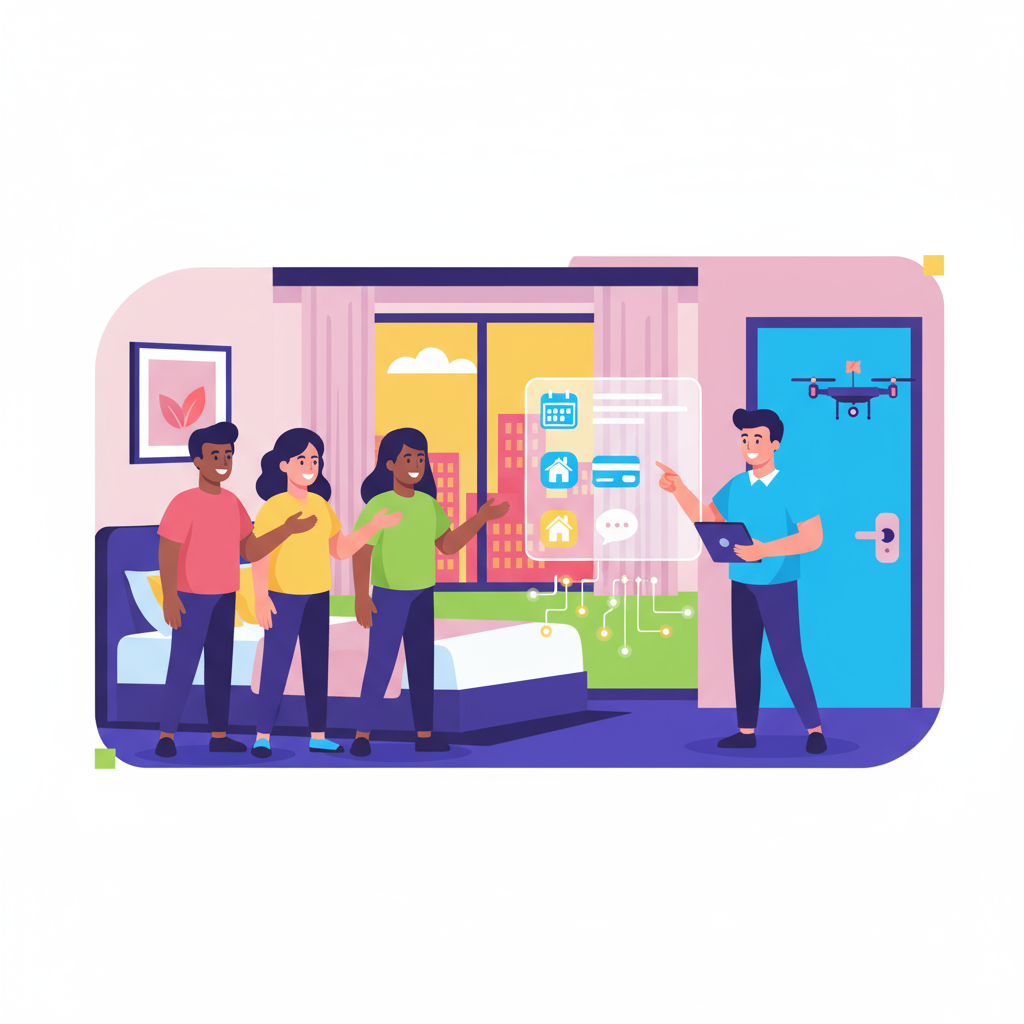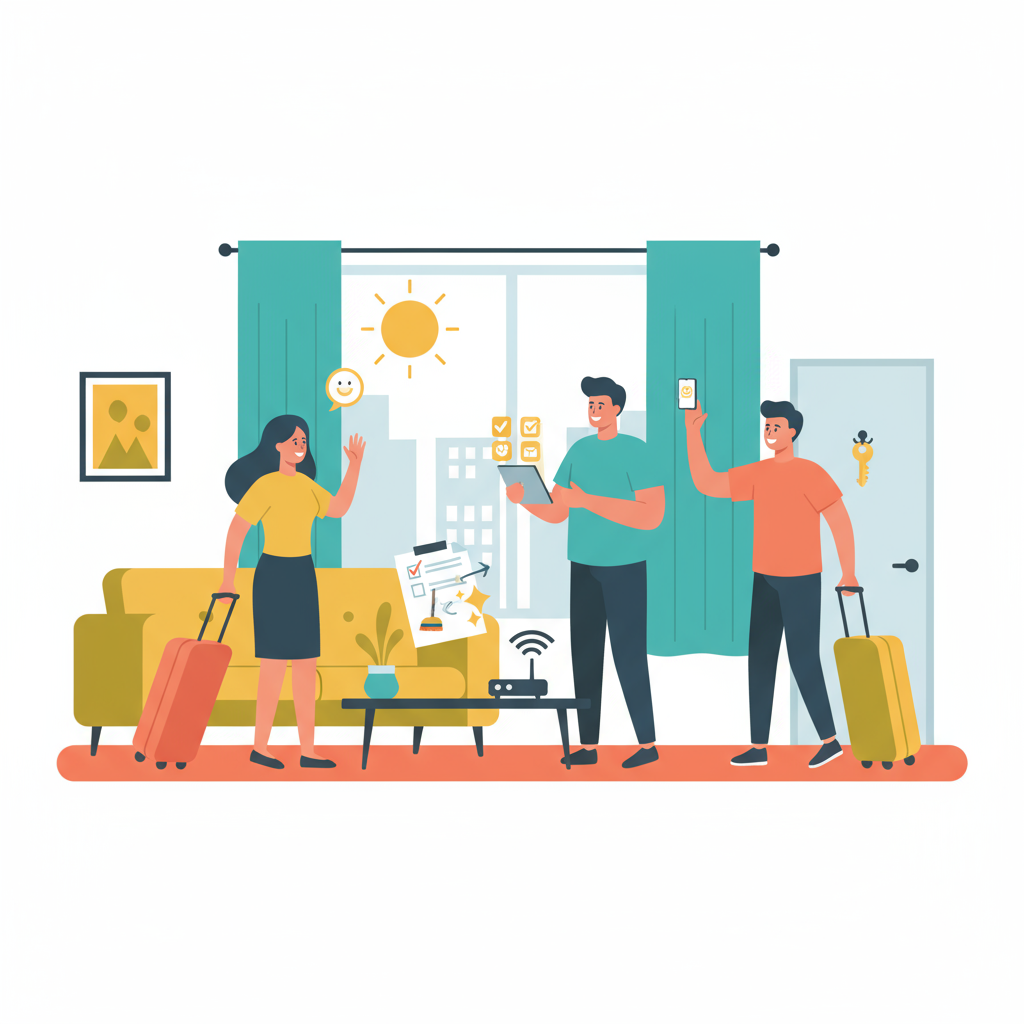Key Takeaways
A well-structured Airbnb listing can significantly impact your visibility, booking rate and guest experience
Your title, photos, amenities and calendar availability all shape how your listing ranks in Airbnb search
Uplisting helps automate pricing, guest communication and availability syncing—saving hours of manual admin
Getting your Airbnb set up right the first time saves you from chasing fixes later. For many starter operators, the early days are packed with trial and error—delayed responses, missed bookings, double entries across calendars. It’s a lot. This guide simplifies the Airbnb set up process into eight straightforward steps so you can launch faster, stay organized and avoid common pitfalls.
We’ll cover everything from legal prep to creating a high-converting listing that ranks well and attracts quality bookings. We’ll also show you how to link your setup with smart tools that remove manual work—so you can run lean without sacrificing performance. Whether you’re listing one place or managing five, this walkthrough gives you a clear, step-by-step path to start strong.
So, here are the eight steps to Airbnb listing success.
Step 1: Make Sure You’re Legally Allowed to Host
Before listing a property, confirm you’re actually allowed to host short-term guests. Short-term rental rules shift not only from one city to the next but also between neighborhoods, buildings, and homeowner associations. Skipping this step during your Airbnb set up can lead to fines, forced cancellations, or a pulled listing before the first guest ever checks in.
Review local short-term rental laws
Start with your city’s municipal website or housing department. Some cities only allow short-term rentals in primary residences. Others set annual night limits or require fire inspections and emergency access plans. A few won’t allow rentals at all unless you meet strict zoning or insurance requirements.
Check your HOA or building bylaws if you’re not in a standalone home. Many boards restrict short-term rentals or ban them entirely. Even if there’s no mention of it, don’t assume you’re in the clear. Ask for written confirmation from the board or management company so you’re not relying on hearsay.
Handle any registration or licensing requirements
Cities with short-term rental programs usually require a license or permit. Some cap the number of active licenses in a zip code or neighborhood. Others tie registration to your tax records or require a local contact person for emergencies. If a license number must appear on your listing, make sure it’s added correctly—some platforms will hide or suspend listings that don’t follow these rules.
Occupancy taxes are another piece to sort out early. In some locations, Airbnb collects and remits guest taxes automatically. In others, you handle payment and reporting. Look up how it works in your city and county, and keep track of every booking and payout. Scrambling through six months of transactions during tax season isn’t how you want to spend time.
Save yourself from your inbox
Automate with Uplisting
Automated guest messages keep your guest informed from booking through to check-out. They’re designed to answer questions before they arise, saving you time whilst keeping your guests happy.
Step 2: Create and Verify Your Airbnb Account
Before your listing goes live, you’ll need a verified host account that builds trust with guests and passes Airbnb’s checks. Setting it up doesn’t take long, but skipping details here can cause friction later. A clean start saves time and avoids problems down the line.
Set up a professional host profile
Guests decide quickly if they trust a host. A photo and bio help tip the scale. Upload a clear, friendly headshot—look at the camera, smile, and use good lighting. Avoid anything vague or outdated. Profiles without photos or with low-quality images tend to get fewer booking requests.
Keep your bio short and helpful. Share who you are, why you host, and what guests can expect from a stay. Two or three sentences are plenty. Focus on the guest experience, not personal backstory. Skip inside jokes or long-winded introductions.
Airbnb asks for a government-issued ID and confirmation of your contact info. Go ahead and knock that out now. Without it, you can’t publish or manage a listing. Verifying your account early avoids roadblocks when you're ready to launch.
Connect payout and notification settings
After your profile is verified, link a bank account to receive payouts. Airbnb sends funds 24 hours after check-in, but errors in account info can delay payment. Double-check your routing and account numbers to avoid payout issues.
Set your notification preferences next. Choose how you want to hear from Airbnb—email, push notification, or text—and test each one. Fast replies keep booking rates high and help your listing rank better in search. A missed message can mean a lost booking or a hit to your response score.
With a verified profile and reliable notifications, you're ready to move forward. Everything else builds from here.
Step 3: Build a High-Converting Listing
Guests don’t scroll for long. A listing either stands out in seconds or disappears into the feed. A strong Airbnb set up puts your property in front of the right people, and actually gets them to book. That means writing clear titles, choosing accurate categories, and using photos that tell the truth—just a better-lit version of it.
Write a search-friendly title
Titles work best when they say exactly what guests care about. Instead of trying to be clever, focus on clarity. Highlight location perks like “walk to beach” or amenities that make life easier, like “free parking” or “pet-friendly backyard.” Mention who the place suits—families, remote workers, couples—so guests know right away if it fits their trip.
Keep it under 50 characters. Anything longer gets cut off on mobile, and most guests won’t click to read more. Skip fillers like “charming” or “lovely.” Use that space for facts that help your listing show up in filtered searches. “2BR Near Convention Center + Garage” gives more booking power than “Stylish Urban Escape.”
Choose the right property type and category
Selecting the wrong category creates instant friction. Guests expect what they filter for—marking a shared home as a private one leads to complaints and refunded bookings. Choose the property type that matches your space exactly. If it’s a converted garage, call it that. If it’s a basement suite, say so. Don’t round up to “entire home” unless guests truly have the whole place.
Room type matters just as much. Guests want to know if they’ll share a bathroom, walk through someone’s kitchen, or have full privacy. Airbnb filters use these fields to match the right stays to the right travelers. Accuracy here means fewer questions, better reviews, and more bookings.
Amenities also shape expectations. A dedicated workspace, in-unit laundry, or fast Wi-Fi can tip the scale for a guest debating between two listings. Don’t just check the box—make sure guests see those features in photos and descriptions so they know you’re not just listing them to check a box.
Upload high-quality photos
 Photos decide who books. If the gallery doesn’t feel inviting, guests move on. Shoot in natural light, open every curtain, and take wide shots that show the full layout. Include every room—especially sleeping spaces, bathrooms, and kitchens. No one wants to guess what the second bedroom looks like or whether the bathroom has a tub.
Photos decide who books. If the gallery doesn’t feel inviting, guests move on. Shoot in natural light, open every curtain, and take wide shots that show the full layout. Include every room—especially sleeping spaces, bathrooms, and kitchens. No one wants to guess what the second bedroom looks like or whether the bathroom has a tub.
Use photos to answer unspoken questions. Where does the entry door lead? Is there parking? What’s the view from the kitchen sink? Exterior shots help guests find the place when they arrive and give context to the neighborhood. If you're near a local landmark or beach access, show it.
Small details matter. Zoom in on features that improve the stay—coffee setups, towel storage, extra blankets, even the thermostat if it’s sleek and easy to use. Don’t just capture what’s in the space. Show how the space feels when guests walk in. If it looks clean, bright, and exactly like the description, you’re already ahead of most listings.
Enjoy the confidence & focus you need to scale your vacation rental business
Book more while doing less
With a reliable VRM solution you can trust, Uplisting can help you grow your business without wasting time on double bookings, unhappy guests, upset clients and worrying what could go wrong next.
Step 4: Set a Competitive Pricing Strategy
Pricing isn't just a number—it filters your listing and controls how guests find, compare, and judge your place. It shapes how you show up in Airbnb search, how you stack up against nearby listings, and whether guests see real value or scroll past. A strong Airbnb set up includes a pricing strategy that fits your local market, meets guest expectations, and still covers your margins.
Start by checking listings nearby that match your size, layout, and amenities. Focus on properties with high ratings and steady bookings. Their pricing likely reflects what guests are willing to pay for a space like yours. Look at how they handle weekday vs. weekend rates, what they charge during holidays, and what added value they offer—like convenient parking or a fully equipped kitchen. Compare those details to your setup. Are you offering more for less or less for more?
Choose the right pricing model
Two options work well: static pricing or dynamic pricing. Static means setting a fixed rate and updating it manually. That works if demand stays steady month to month—but even small towns have school holidays, festivals, or busy weekends that shift guest behavior. Dynamic pricing adjusts your rate automatically based on season, day of week, lead time, and local demand.
Dynamic pricing also helps fill short gaps between bookings. A two-night window can stay empty at full price, but a small drop might attract a last-minute guest. For hosts juggling multiple calendars, automated rate updates save time and prevent missed opportunities during high-demand periods.
Set your base rate and fees
Start with a base rate that covers your lowest expected demand and still turns a profit. Then add weekend and holiday increases where they make sense. Friday and Saturday nights often carry the most demand, especially in urban or leisure markets—price them accordingly.
Set cleaning fees based on your actual costs. High cleaning charges can make a short stay feel expensive and push guests toward listings with more reasonable totals. Guests also see platform service fees in their final price, so make sure your nightly rate stays competitive even after those are added.
Use price to position your listing
Rates send a message. A higher price paired with professional photos, fast responses, and thoughtful extras still converts if the experience matches the cost. On the flip side, charging more than the booking experience can deliver leads to poor reviews and fewer future guests.
Check your pricing often. Local demand changes, competition evolves, and what worked last quarter might leave money behind now. A flexible strategy gives you room to adjust instead of getting stuck with outdated numbers.

Step 5: Prepare the Space for Guests
First impressions don’t end at the front door. Clean sheets and a strong Wi-Fi signal matter, but guests also notice whether they can find a coffee mug without opening every cabinet. Preparing your space is about making the stay smooth, predictable, and—ideally—pleasant from the second someone walks in.
Start with the basics guests expect to see but often don’t think to ask for. Bathrooms need full toilet paper rolls and extras within reach. Provide clean, clearly folded bath towels, hand towels, and washcloths in every bathroom. Keep the kitchen ready for real use. That means simple cookware, enough dishes and utensils, and go-to staples—like salt, pepper, cooking oil, and coffee. For any listing with a full kitchen badge, guests assume they can cook a full meal without improvising.
Safety first, always
You won’t always get credit for it, but skipping safety checks can backfire fast. Test smoke detectors and carbon monoxide alarms every month. Keep a visible first aid kit stocked with basics—bandages, antiseptic wipes, and pain relief meds. If the layout includes stairs or uneven flooring, plug in a few nightlights to reduce risk. These aren’t just for compliance—they show attention to detail and care for guest comfort.
Add small touches that feel personal (but not personal)
 Comfort doesn’t come from big gestures. It shows up in the quiet stuff guests notice without needing to mention. A couple of board games, a deck of cards, or a puzzle can turn an off night into something memorable. A few packaged snacks—granola bars, trail mix, or chocolate—can hit the spot after a long check-in day. Travel-size shampoo, conditioner, and body wash help when guests forget something or pack light.
Comfort doesn’t come from big gestures. It shows up in the quiet stuff guests notice without needing to mention. A couple of board games, a deck of cards, or a puzzle can turn an off night into something memorable. A few packaged snacks—granola bars, trail mix, or chocolate—can hit the spot after a long check-in day. Travel-size shampoo, conditioner, and body wash help when guests forget something or pack light.
Leave a short, printed welcome note or a local guide with tips about coffee shops, late-night food, and directions to the nearest grocery store. Include Wi-Fi details, check-out steps, and property specifics—like where to park or how to adjust the thermostat. Keep everything brief, clear, and easy to find. No need to overdo it. Just answer the questions before they’re asked.
You’re in great company
Sign up
Some of the largest short-term rental operators (with 250+ properties) rely on Uplisting's software to scale their businesses.
Step 6: Set Up Availability and Booking Preferences
Once your listing is live, an out-of-date calendar or rigid booking settings can throw a wrench into everything you’ve built so far. You don’t want to lose a high-value reservation because your calendar didn’t update fast enough—or worse, accept a booking you can’t honor. A strong Airbnb set up keeps your availability accurate and your booking preferences smart from the start.
Sync your calendar
Start by connecting your Airbnb calendar to any other platforms you’re using—Vrbo, Booking.com, or a direct booking site. When calendars don’t talk to each other, you’re stuck updating every one manually. That’s where mistakes creep in. Double bookings, missed cancellations, and last-minute gaps can all be traced back to disconnected systems.
A connected calendar keeps everything in sync. New reservations, changes, and blocked dates update automatically across all platforms. No more guessing whether a weekend was booked through Vrbo and forgotten on Airbnb. If you’re managing more than one property, real-time syncing isn’t a luxury—it’s the only way to stay on top of it all without babysitting every tab.
Configure booking settings
Once your calendar’s synced, fine-tune how guests can reserve your place. Decide whether to turn on Instant Book. If your property’s ready for short-notice arrivals and you’ve got a reliable cleaning team, Instant Book can help you show up earlier in search results and reduce back-and-forth with guests. But if you’d rather screen guests before confirming, leave it off and stick with manual approvals. Just keep in mind: slower response times can drop your listing’s visibility.
Next, nail down your stay requirements. Set a minimum number of nights that covers turnover costs without scaring off short-stay guests. Many hosts go with two nights, but if your location attracts weekend traffic or events, a three-night minimum might make more sense. If your cleaner needs extra time between guests, add a booking lead time—24 or 48 hours—to avoid rushed turnovers.
Don’t overlook your cancellation policy. Flexible terms appeal to travelers booking further out, but they also open the door to last-minute cancellations. A moderate or strict policy helps protect your calendar, though it might reduce early bookings. Think about the type of guest you’re targeting—and how much risk you’re willing to take.
Every setting here shapes who finds your listing and how easy it is for them to book. When calendars are synced and booking rules are set with intention, you’re not just avoiding mistakes—you’re staying available to the right guests at the right time.
Step 7: Publish and Go Live
Everything’s in place—your pricing is set, photos are uploaded, and the calendar is synced. Before you hit publish, take a final look through the listing. Small details like a typo in the title or a missing amenity tag can push guests toward another property. You only get one shot at a first impression, so make it count.
Double check listing details
Read the description out loud. It’s one of the fastest ways to catch clunky phrasing, run-on sentences, or anything that sounds off. Then go line by line through each photo caption. Make sure captions actually describe what’s in the photo, and say something useful. If the second bedroom doubles as a workspace or the backyard includes a grill, say so. Captions help with search visibility, too.
Preview the listing on both mobile and desktop. Most bookings come from mobile, but guests still check listings on laptops when planning longer stays. Make sure the title looks clean, formatting stays consistent, and the cover photo centers properly. If the image crops awkwardly or the headline gets cut off, swap it out. Clear visuals and clean formatting reduce confusion and help guests book faster.
Respond quickly to new guests
After your listing goes live, Airbnb tracks how fast you respond to new inquiries. Delays hurt visibility. A fast response—usually within an hour—improves your ranking and gives guests confidence that you’ll handle their stay well.
You don’t need to reply manually every time. Set up auto-replies that acknowledge the message and tell guests when to expect a full response. Use saved replies for common questions about check-in, Wi-Fi, or parking. You’ll save time and still come across as helpful and responsive.
First-time guests shape your review history, boost your ranking, and drive momentum. A fast, friendly reply shows you're ready—and makes guests more likely to book with confidence.
Create 5-star guest experiences
Give your guests unforgettable experiences
With Uplisting, you can send the right messages at the right time on all booking sites. Read and respond to guest messages in a single, unified inbox — whether you’re at the office or on the go.
Step 8: Streamline Operations With Uplisting
 Running short-term rentals manually gets overwhelming fast—especially when bookings pick up and the inbox doesn’t stop. Every guest expects quick responses, clear instructions, and a smooth arrival. Without reliable systems in place, mistakes start to pile up. Missed reviews, late check-in details, pricing gaps. It’s not just extra admin—it’s lost revenue and preventable stress.
Running short-term rentals manually gets overwhelming fast—especially when bookings pick up and the inbox doesn’t stop. Every guest expects quick responses, clear instructions, and a smooth arrival. Without reliable systems in place, mistakes start to pile up. Missed reviews, late check-in details, pricing gaps. It’s not just extra admin—it’s lost revenue and preventable stress.
Automate guest communication
Clear, timely messaging makes a big difference. Guests need check-in instructions before arrival, house rules that are easy to follow, and checkout reminders that don’t feel like an afterthought. Automating these messages ensures everything arrives exactly when it should—without having to rewrite the same answers over and over.
Pre-scheduled messages help set expectations early, reduce questions, and keep the guest experience consistent. Review reminders go out automatically after checkout, giving guests a nudge while the stay is still fresh in their mind. No more chasing five-star reviews or copy-pasting late at night.
Avoid undercharging with smart pricing
Pricing every night manually doesn’t scale. Market demand shifts constantly—weekends, events, holidays, school breaks. A pricing tool adjusts your rates in real time based on trends, local occupancy, and what similar listings charge nearby.
You stay in control with minimums, caps, and strategy rules, but the tool handles the daily changes. Lower rates when calendars are empty, raise them when demand spikes. The goal is to fill nights without guessing what guests are willing to pay.
Keep your operations in one place
Juggling multiple calendars, message threads, and bookings across platforms wastes time. A centralized dashboard puts everything where you can actually use it. View guest messages, reservation details, and availability from one tab—no need to bounce between six browser windows.
Block off dates, change pricing, and respond to guests without switching tools. Stay on top of bookings, cleaner schedules, and guest questions from one screen. When everything runs through one system, nothing gets missed—and your days run smoother.
Sign up for Uplisting to streamline your vacation rental management.
The Best Listings Start with Uplisting
Setting up your Airbnb listing the right way sets the foundation for long-term success. A clear profile, competitive pricing, and accurate availability all help attract more bookings and five-star reviews, helping you keep more money in your back pocket.
But once your listing is live, keeping your operations efficient becomes the real challenge—especially as your portfolio grows. Automating communication, syncing calendars, and optimizing pricing daily are key to reducing manual work and avoiding costly mistakes. That’s where a dependable property management system makes all the difference.
If you're ready to simplify your workflow, improve guest satisfaction, and scale your short-term rental business with confidence, Sign up for Uplisting to streamline your vacation rental management.
All-in-one Vacation Rental Software and Channel Management System
Get started in seconds by connecting Airbnb
Manage short-term rentals & bookings, message guests, take payment, and so much more. All in one easy-to-use platform (that never double-books).
FAQs About Setting Up Your Airbnb Listing
Do I need a business license to host on Airbnb?
Some cities ask you to get a business license before listing a property. Others only enforce those rules for hosts with multiple units or full-time rental setups. The only way to know for sure? Check your city’s municipal website—don’t rely on forums or secondhand stories. Airbnb’s regulation page can help you get started, but your local government will have the final say.
What photos are most important for my listing?
Photos sell your space long before guests read a single word. The first five images show up in search results, so choose carefully: living room, main bedroom, bathroom, kitchen, and one strong exterior shot. After that, fill in with details that matter—workspace, patio, coffee station, laundry area. Show how the space looks and how guests will actually use it.
How do I keep my Airbnb listing competitive?
Keeping your listing ahead of others means staying active. Update photos when the seasons change or when you upgrade furniture. Respond to new inquiries within an hour—faster replies improve your ranking. Adjust pricing anytime demand shifts, especially for local events or holidays. Strong Airbnb set up tools can handle these tasks automatically, so you don’t lose time juggling everything manually.
What if my listing isn’t getting bookings?
Start with visibility. Are the photos sharp and well-lit? Does the title clearly say what you offer? If your calendar and pricing look fine, reviews often point to the real problem. Look for gaps in communication, unclear instructions, or maintenance issues guests mention. Fixing small pain points—like late check-in info or a missing fan—can help turn views into bookings faster.
Can I change my listing after it goes live?
You can, and you should. Update photos if you change decor or add amenities. Adjust pricing when demand changes. Add new features to the amenities list as you improve the space. Avoid editing the title too often, though—frequent changes can hurt search visibility. Make each update count by focusing on what helps guests book with confidence.
How far in advance should I open my calendar?
Open it at least six months ahead to catch early planners and longer stays. Many guests don’t book last-minute, especially for peak seasons or events. A short calendar window can quietly turn away high-value bookings. Just make sure your pricing and availability are accurate before opening future dates. Guesswork here leads to cancellations down the line.



 Photos decide who books. If the gallery doesn’t feel inviting, guests move on. Shoot in natural light, open every curtain, and take wide shots that show the full layout. Include every room—especially sleeping spaces, bathrooms, and kitchens. No one wants to guess what the second bedroom looks like or whether the bathroom has a tub.
Photos decide who books. If the gallery doesn’t feel inviting, guests move on. Shoot in natural light, open every curtain, and take wide shots that show the full layout. Include every room—especially sleeping spaces, bathrooms, and kitchens. No one wants to guess what the second bedroom looks like or whether the bathroom has a tub.
 Comfort doesn’t come from big gestures. It shows up in the quiet stuff guests notice without needing to mention. A couple of board games, a deck of cards, or a puzzle can turn an off night into something memorable. A few packaged snacks—granola bars, trail mix, or chocolate—can hit the spot after a long check-in day. Travel-size shampoo, conditioner, and body wash help when guests forget something or pack light.
Comfort doesn’t come from big gestures. It shows up in the quiet stuff guests notice without needing to mention. A couple of board games, a deck of cards, or a puzzle can turn an off night into something memorable. A few packaged snacks—granola bars, trail mix, or chocolate—can hit the spot after a long check-in day. Travel-size shampoo, conditioner, and body wash help when guests forget something or pack light. Running short-term rentals manually gets overwhelming fast—especially when bookings pick up and the inbox doesn’t stop. Every guest expects quick responses, clear instructions, and a smooth arrival. Without reliable systems in place, mistakes start to pile up. Missed reviews, late check-in details, pricing gaps. It’s not just extra admin—it’s lost revenue and preventable stress.
Running short-term rentals manually gets overwhelming fast—especially when bookings pick up and the inbox doesn’t stop. Every guest expects quick responses, clear instructions, and a smooth arrival. Without reliable systems in place, mistakes start to pile up. Missed reviews, late check-in details, pricing gaps. It’s not just extra admin—it’s lost revenue and preventable stress.











.png)

